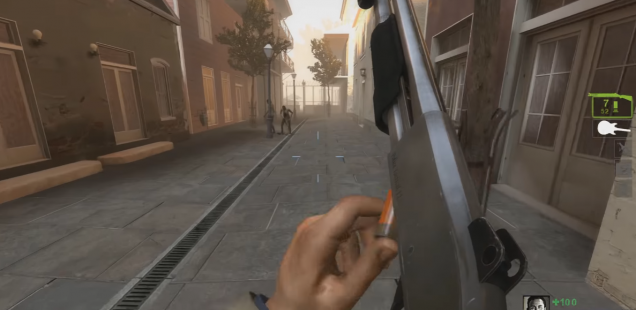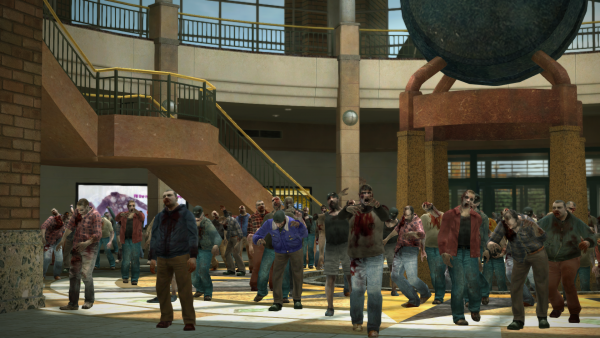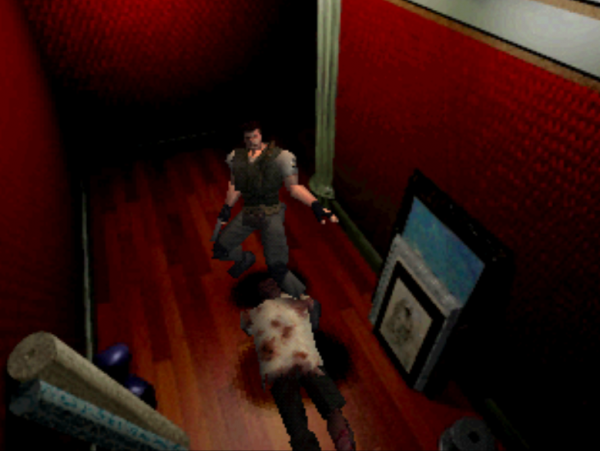
Video Game Viruses and Dehumanization
B.G.M. Muggeridge on the symptoms of the illness.
Zombies are the main representation of viral infection in a number of video games. For decades, a wide range of scholars, journalists, and critics have addressed the latent fear of ‘the Other’ that zombies represent, human-like but different enough from our sense of ’normal’ humanity that enacting violence towards them is permitted. The zombie as a cultural signifier represents various anxieties about the modern human condition, particularly regarding the economic and demographic shifts in countries such as the United States, the United Kingdom, France, and others over the last few decades, often with a reactionary, nationalist tone.
Game narrative and design differ from film or literary depictions of viral outbreaks, and can help enlighten us about our personal and political responses to such phenomena There are two main points I’d like to examine: first, the presentation of zombies akin to consumers, and second, their physical traits, distorted beyond a standard image of the human body, and the ideological implications of this distortion. Both aspects of zombie design exist to form an image of zombies in the highly political context of racialization. I have chosen a few games to cross-examine these questions, ones we are all likely familiar with: Dead Rising, Left 4 Dead, Resident Evil and The Last of Us.
Consumption
Dead Rising takes much of its inspiration from the film Dawn of the Dead (1978), which began a trend of zombification that challenges the concept of capitalist consumerism and consumption. The zombies are drawn to the shopping mall, as the character Peter describes ‘they’re after the place. They don’t know why, they just remember. Remember that they want to be in here.’ The inherent desire to consume is exacerbated by the virus and that leads people to the place they mentally associate with consumption, the shopping mall. In Dead Rising we play as Frank West, a freelance photojournalist whose job guides him to investigate a military quarantine in the town of Willamette, Colorado, where he discovers a zombie virus outbreak. The plot is a contrived vehicle for certain design choices that reflect a unique, gameplay-driven development of Dawn of the Dead’s critique of consumer culture. Rather than the mall being a vacuous, empty place of limited resource, it is abundantly filled with food, water, and a huge variety of items the player can pick up, throw, shoot, and drive to make this akin to a murder playground.
There’s a distinct shift from a passive cinematic critique about the nature of consumerism to an interactive sandbox environment, in which many objects within the shopping mall have value for the primary means of dispatching zombies. The sandbox format acts to personalize the critique in a way the more linear narrative of film cannot, reflecting how our ‘freedom’ to explore is still governed by the logics of consumer behavior. Frank, as a tool for the player, is presented as a uniquely autonomous being by the responses and behaviors of NPCs towards him, maintaining his sense of creativity to use the vast array of products available to him whilst the infected around him flail ineffectively.

Consumption becomes a powerful mirror. The zombies physically consume, eating humans alive and thus turning them into more zombies. Their actions reflect a base humanity entirely driven by the need to survive and exacerbated by the virus. Zombies herd together, again appealing to a concept of primitive human behaviors, socially grouping together for survival. The shopping mall acts as an ironic reversal; zombies mindlessly consume, Frank creatively consumes. This reappropriation of consumer culture is Frank, and the player’s, main weapon against the zombies, a feature that cements Dead Rising as a parody of zombie media. It appeals to the change in American consumerist critique, from Conservatism to Neoliberalism, in which ‘Freedom’ characteristic of traditional American approaches to politics is reinterpreted as the act of consumption. The zombies’ consumption is conformist, mindless in its infectious power and renders everyone identical, in spite of the zombies’ freedom to roam the mall and ostensibly do as they wish. Frank rejects this conformity, instead using the output of mass production to assert his independence; his consumption becomes an act of personal defiance, and Frank resembles a kind of Neoliberal übermensch.
Other zombie games, like Resident Evil, offer a version of this consumerist critique but instead frame a primitive dehumanization in the context of corporate scientific development. The T-Virus is man-made by the Umbrella corporation, placing ultimate responsibility upon corporate cruelty and malpractice rather than the mass of consumers. The virus was originally designed to be a highly contagious modification to Ebola that could act as a bio-weapon; Albert Wesker asks ‘[what] If a person who was heavily infected (the disease had spread all throughout their body) could actually stand and walk around? And, without knowing it, was in direct contact with other people, of their own accord…’ These zombies echo notions of alienation, where individuals are dehumanized in their role as tools for a ruling capitalist elite. Not only are people disposable, but their bodies are also reappropriated to enact the will of the very system that exploits them. This will manifests as the consumer behavior, heightened to the physical consumption of other people. Alienation therefore causes humans to dehumanize themselves from their humanity, but act as the agents of dehumanizing others through consumer behavior.
The Last of Us perhaps has the most interesting concept virally, notably not being a virus at all but a fungus. Based on the Cordyceps fungus, the CBI (Cordyceps Brain infection) was explicitly designed, according to creative director Neil Druckmann, to possess a kind of ’natural beauty.’ The zombies here are more conceived as occupiers than consumers, with their capacity to alter the environment mirroring humans’ ability to alter theirs. Druckmann also quite plainly states ‘[the virus] was all based on the idea that the more numerous a species becomes, the more likely it is to be preyed on by this fungus.’ Human control over the environment is what caused our capacity to explode in terms of population, again, a precursor to the ironic reversal of the zombies. However, there is a touch of certain eco-fascist arguments of over-population, that natural forces have determined humans to be too numerous and therefore must be ‘culled.’ I could not find any evidence to suggest fungal infection rates correlate to population size, although I confess my lack of expertise in this field. Regardless, this description coheres to many similar assumptions about human population that filter into the ideological structure of the game, such as the assumed descent of survivor groups into violence, or the suspension of ethical medical practice to secure a vaccine. Consumption, in the form of the fungus, is made a natural force, in which humans’ capacity to spread across the globe is what makes them susceptible to a consumption themselves.
Physicality
The behavior of zombies is only one half of the equation, with the other being their visual design. Physicality is fundamental to the process of dehumanization. The further we move from the standard silhouette of human anatomy, the more we can rationalize violence against it. Shuffling movements and guttural, tortured, shrieking vocalizations are the standard, but many games introduce further physical deformation. Left 4 Dead has its ‘special infected’ in the form of Spitters, Bloaters, Tanks, Witches, and many others, whilst The Last of Us has Clickers, Bloaters, Stalkers, etc. Resident Evil takes this further, with examples of the Umbrella Corporation having infected other animals like dogs. The immediate effect this has is to render the human zombies closer to animals than humans, much like the spores in The Last of Us. But noteworthy in each of the aforementioned consumption metaphors is an anxiety about the human body, particularly its weakness. Zombie variants, in this case Left 4 Dead’s, act as visual metaphors for such anxieties: Bloaters represent gluttony, Spitters the visceral weakness of humans to disease, Tanks an image of hyper-masculine violence, Witches the fear of the feminine, and so on. Note that this tendency is almost exclusively cultivated by the logics of game design. In order to justify a varied gameplay experience, various ‘types’ of different undead monsters need to be created.

The classic-looking zombie still makes up the vast proportion of the enemies in these games, even though the trope of the shambling corpse does not dominate. The speed of the zombies in Left 4 Dead and The Last of Us is arguably a more interesting development than the traditional, slow Dead Rising depiction. Comparisons have been drawn between the alienated image of the zombie human and the modern refugee crisis, and thus it stands to reason that the American consumerist origins of the shambling zombie have evolved into an internationalist anxiety about desperate migrants; their mobility is their danger. This comparison holds, as these games fit the timeline of this change and also can be found in most other depictions of zombies as well, such as faster zombies in Zombieland, 28 Days Later, World War Z, and many others. These films use quarantine and borders as important plot points for the control of the highly mobile zombies, resembling the ways in which modern states construct barriers against migrant communities. World War Z has the most obvious example, as a containment wall in Israel has zombies physically clambering over each others’ bodies to breach the wall; an intensely political image given settler-colonial fears of migrants breaching the border. 28 Days Later depicts the reverse, in which the rest of the world ‘quarantines [Britain]’, denying people the ability to seek refuge across the English Channel. A country whose own history is defined by the ability to move freely and is increasingly dominated by anti-migrant rhetoric, finds itself the victim of the same systems it uses to limit others.
Each mutation beyond the standard appearance and behavior expected in humans thus exists in a network of different ideas, many of which have very real social comparisons and are each bolstered by the need for an engaging gameplay experience. Even zombie vocalization has these problems, heightening parts of human vocal expression unused in American/British English that appear regularly in other dialects. Resident Evil 5 even had its infected speak Swahili. The human body becomes dehumanized by its association to the inhuman, physically, vocally and behaviorally. In turn, that which is outside of accepted western concepts of normality in speech and appearance is also subject to this dehumanization.
Racialization
We can further link this to an often-overlooked characteristic of zombies: their skin tone. The politics of color is a deeply important thing to consider when discussing dehumanization. For centuries, dominant imperial powers established whiteness as a political construct in opposition to peoples of color, primarily to justify the dehumanization of colonized peoples. It’s logical that the walking dead often appear pale, lacking blood-flow and presenting a corpse-like gray. This color therefore has an interesting demonstrative effect on our conceptions of whiteness; in altering the physical whiteness of the zombies, even slightly, we can see how the process of racialization is an active construction rather than a physical reality. Our assumptions of whiteness as politically ‘neutral’ are disrupted in a way we are not used to.
Other depictions may present darker skin due to decomposition or stains of blood. As opposed to disrupting whiteness, the danger is in coding the zombie as the non-white ‘Other,’ existing outside of the acceptable bounds of human appearance, as governed by wider cultural trends of ‘neutrality.’ Resident Evil is the worst culprit for this and provides us with troubling correlations. As mentioned previously, Resident Evil 5 has primarily Black zombies due to its setting in Africa, who speak in Swahili. Resident Evil 4 also suffers from this, as the zombies primarily speak Spanish. It is easy to explain away these features diegetically, as different forms of the virus to the ones in earlier games, but the effect is still to associate non-English dialects with the dehumanized zombie. Earlier games were set in the US, yet the absence of spoken English in the zombies is stark; sounds the average player would consider familiar would disrupt the function that zombies serve.

Representation has become the primary means of challenging the dominant whiteness in game design and development, remaining an important topic of discussion for criticism. Designers also need to consider how racialization exists not only at the level of text, but in a subtextual collusion between inherent ideological and cultural assumptions embedded into the design logic of video games themselves. The color of the zombies cannot be separated from the function it serves as a distinguishing feature, reinforced by vocal alienation and showing us how easily new categories of racial coding can be created and subsequently acted upon. Think of how certain enemy types fit into historical contexts. Whilst Nazis are an easy, catch-all enemy for the World War II video game (given there is no reason one should morally object to enacting violence against them) games based on wars in Afghanistan or Iraq are not so simple, potentially causing active associative behaviors in gamers.
Linking the physicality of zombies to questions of race is not an immediately obvious thing to do, however the parallels are undeniable: a group of individuals, generalized as a threat in order to facilitate violence against them, as we are encouraged by constructed systems to assume physical traits are indicative of value. Physicality is therefore not just a simple design choice. In the same way we construct social systems, we construct mirrors of these systems in the culture we enjoy. The totalizing effect of consumption and physicality creates a powerful Other. Zombies reflect numerous different kinds of assumptions, ranging from race, gender, disability, and ideology. Left 4 Dead is the best example, as the many different forms the undead take each demonstrate types of physical distortion common to human fear. All are based on very real social stigma, tying together multitudes of dehumanizing representations and, similarly to Resident Evil, exposing inherent cultural prejudices. Zombies, like many monsters, act as mirrors for the anxieties of the time in which they exist, and as race maintains a strong political motivator in our societies, so does racialization maintain strong influence over cultural and entertainment media.
Zombies are an easy stand-in for danger and disposability. We have seen the ways players render zombies as less than human via their consumptive practices and their physicality, as well as how these connect to wider questions of political identity. It is worth remembering that most zombies did not choose to become so! Ethical questions of representation become more significant when we consider the multiple levels of autonomy that these creatures lack and what assumptions are made in order to render them subject to mortal violence.
But zombies are only half the equation. In a second piece to follow, I would like to draw attention to the protagonists of these games. We’ve seen some elements of the distinction between player-characters and non-player characters, but there is something far deeper at work in how players relate to player-characters and what actions they can perform. Video games submit to ideological assumptions inherent not just to wider political issues but also at the level of design itself. The weakness of the human body is made obvious to us in the case of the zombie but acts in direct contrast to the resistance and power of the body of the hero. We have seen people dehumanised; next is understanding who counts as more than human. This dynamic builds into the overbearing feature all virus-based games possess: a complex process of determining physical space as a political environment. To fully understand how this works, the relationship between human players and zombies must be fully explored, as well as how violence exerts control over the behavior of the player.
B.G.M. Muggeridge is a freelance games and politics writer. He is a research graduate of Cultural Studies from the University of Nottingham, where he specialized in the construction of complicity in Video Game design.